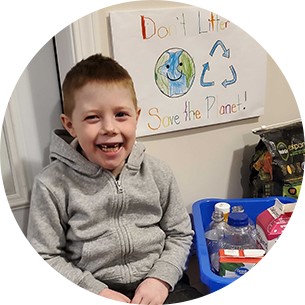| So here’s a question for you – have you seen a frog lately? For some, it’s a regular occurrence, but for urban dwellers like me, it can be as rare as a shooting star! Even with all the time I spend in nature, I can count on one hand how many frog encounters I’ve had in the last decade. I can also tell you this, I remember exactly where and when I saw them. Seeing something that lives in the wild hop across your path is such a thrill. For me, seeing wildlife triggers an instant jolt of wonder. |
 |
| There’s been a massive body of research conducted over the years that outlines the powerful connection between humans and animals. In 1984 biologist E.O. Wilson, introduced the idea of “biophilia”-the innate affinity we humans have for other living things. For children, it’s believed they’re born with an intrinsic sense that animals are important. There are enough videos on Tik Tok of adorable kids with their pets to convince even the most ardent skeptic that children LOVE animals! But when youngsters are exposed to wildlife, there’s an even greater potential for engagement. |
 |
| Even if children spot common wild creatures like squirrels, rabbits or ducks, they get that these animals are FREE in nature. Kids comprehend that animals who live in the wild, have to find their own food, build their own habitats and endure all kinds of weather. More importantly, they witness these animals utilizing super powers like flying, digging, and climbing without any regard to an owner’s command. They can also disappear quickly, which, creates mysterious chance encounters. All of this contributes to a sense of awe and wonder. |
 |
| There’s an excellent opportunity here for parents to tap into this heightened sense of engagement by nurturing a child’s curiosity. It can be as simple as asking a question like; “Why do you think those squirrels are chasing each other?” or “What do you think a rabbit eats in the winter?” Their answers are often loaded with evidence that kids love to THINK about animals – especially their superpowers! Earth Rangers Missions are another excellent way to tap into that passion. The Backyard Biologist Mission, for example, stokes a child’s curiosity by tapping into their observation skills. We encourage families to head to their local park, pond, garden or their backyard to look for plants and animals together. This is citizen science at its best! The Mission includes helpful prompts and a handy guide to help identify types of species. The Backyard Biologist Mission educates children in detail about biodiversity and it’s loaded with fun hands-on activities. There’s also another wonderful opportunity that presents itself when children explore their natural surroundings. Parents have the chance to nurture a sense of stewardship for the planet. |

The Respect Animals While Recycling Mission (R.A.W.R) makes the connection between waste and wildlife by fostering a sense of responsibility for the things we throw away. Kids learn how rinsing containers, waste sorting, and composting help protect animal habitats by making recycling-material safe. If not properly maintained, our garbage can also become an enticing spot for animals to visit! R.A.W.R. reminds all of us that we should work towards a respectful distance between humans and wildlife.
| Earth Rangers Missions, along with all of our programs, are about helping children feel a sense of empowerment. It’s rooted in everything we do. Our end goal is to encourage eco-action. It starts at the beginning with a child’s sense of curiosity and wonder. For us adults, it’s an encouraging reminder that the seeds have already been planted. This intrinsic connection to animals doesn’t need a lot of help. It’s like a fire that’s already been lit. We just need to feed the embers and coax it along. Asking questions, participating in Missions and taking time to observe our natural surroundings are great places to start. Sharing a sense of wonder helps too. Freaking out over a frog may not be everyone’s go-to, but my three kids get a kick out of seeing their mom get excited about a chance encounter in the natural world. |


